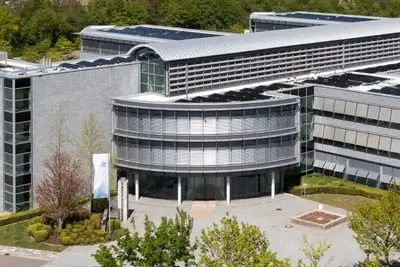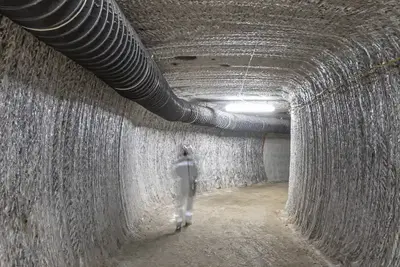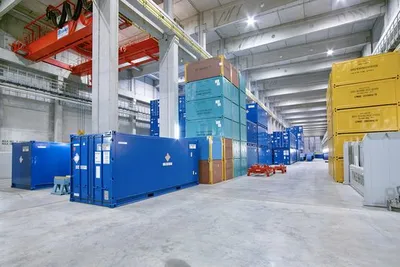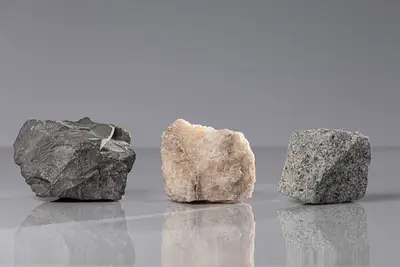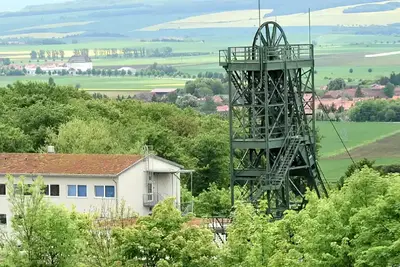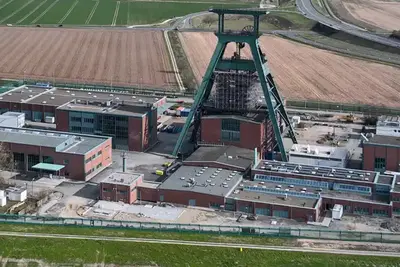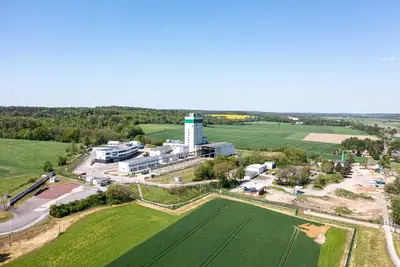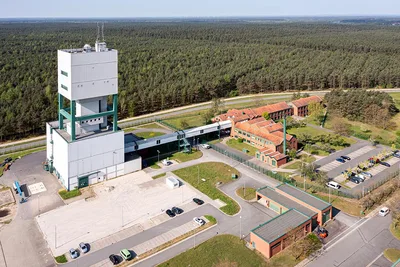Key findings of Phase 1 of the evaluation
The contractors compared the state of the art of science and technology in 2002 – when the planning approval (PDF, 2,41 MB, German only) (PDF, 2,41MB) was issued – with that in 2018. They identified a series of changes, some of which were assessed as being relevant to the safety analyses of the Konrad repository. The BGE is therefore now also planning Phase 2 of the evaluation. However, it is worth noting that, for the vast majority of the issues examined, no changes were discovered and therefore no need for action was identified. Summarising the final reports, the reviewers write: “In the peer review team’s estimation, there is no indication in Phase 1 of aspects based on which the safety assessment is to be fundamentally called into question.” The Konrad repository is a robust system. When applying for a licence for the repository, the former operator made numerous conservative assumptions that also stand up to evaluation by newer methods. However, there is also a need for further examination of a number of points in Phase 2 of the evaluation.
New laws, standards and ordinances
For all topics under evaluation, there have been some changes to the legal requirements, be they laws, ordinances or standards. This applies to the calculation of the radiological effect on humans, for example. Since the planning approval was issued for the Konrad repository, there have been fundamental methodological changes in the way that radiation exposure is calculated. This difference, or discrepancy, between the state of the art of science and technology today and that in 2002 is therefore addressed in several expert reports – and results in a need for action in several of the examined subject areas. The second area that has seen significant changes is the power of computers and above all of mainframe computers. Assessments of long-term safety using “probabilistic methods”, which can be used to assess statistical probabilities, have only become state of the art over the course of the last 20 years.
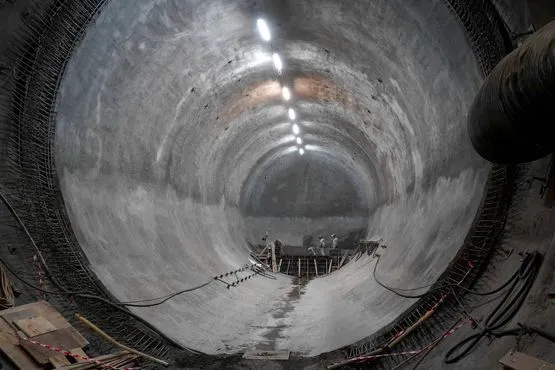
This is what most of the repository infrastructure looks like following expansion.
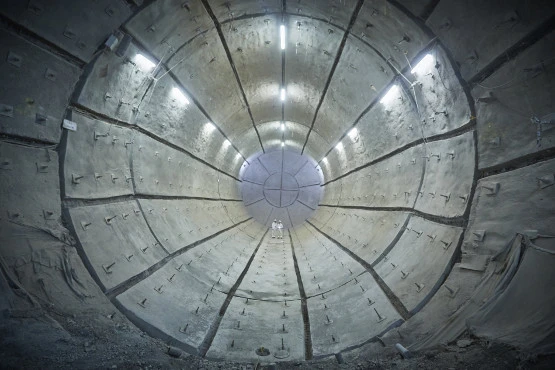
The repository is being expanded in accordance with strict safety requirements.
Long-term safety analysis of the post-operational phase
The geological situation of the overall system was examined in detail in the long-term safety analysis (PDF, 1,99 MB, German only) (PDF, 1,99MB) for the Konrad repository, and the assessments took account of the exploratory findings from boreholes and insights into the conditions underground. The contractors – GRS, AF-Consult and DMT – examined whether reassessment is necessary when it comes to long-term observation, for example due to new insights from the construction phase of the Konrad repository or from comparable sites, or in light of a change in the state of the art of science and technology. At the same time, the contractors also incorporated opinions and sets of rules from the advisory bodies to the federal government on the safety of nuclear facilities, such as Statements by the Nuclear Waste Management Commission (ESK).
Stress test for the Konrad repository
The Konrad repository, which will be used to store waste with negligible heat generation, is subject to different safety requirements from those for a repository for heat-generating waste. Nevertheless, as part of a stress test, the contractors applied the exclusion criteria used in the current search for a repository site for high-level radioactive waste to the Konrad repository system – and did not identify any criteria for exclusion. The Repository Site Selection Act (StandAG) defines an essential safety concept known as a “containment-providing rock zone”. The rock is intended to act as the main barrier to the radionuclides in order to protect people and the environment from radiation. The contractors make a favourable assessment of the Konrad repository system as a whole, and especially of its overlying strata. They report that, for the Konrad repository, the “area extending approximately 10 kilometres from the repository horizontally and down to the upper edge of the Lower Cretaceous stratum vertically could be defined as a containment-providing rock zone”. The requirements of the Repository Site Selection Act would therefore be met. According to the contractors, the Konrad repository therefore adopts a geological barrier as a safety concept that meets the state of the art of science and technology. That is also the assessment of the peer review team.
Computers have become much faster
The contractors state that: “At the time when the Konrad long-term safety analysis was drawn up, probabilistic uncertainty analyses – which require a large number of model calculations – were not yet state of the art due to the limited capacity and speed of the computers available.” In this area, there have been significant advances in terms of methodological development. The contractors therefore criticise, including with regard to the current state of the art of science and technology, that the long-term safety analysis for the Konrad repository did not include a systematic description of the handling of uncertainties. This is one area in which they identify a need for improvement, although they add that this could easily be delivered by means of a systematic reappraisal by experts. In addition, the peer review team indicated in its expert report that the model calculations performed on behalf of the planning authority also help to instil greater confidence in the robustness of statements regarding safety.
How do radioactive substances move around?
In order to move around or out of the system, radionuclides require a means of transport – the obvious thing being water, although there are also other carrier media such as gas. In addition, substances can also be finely dispersed in water in the form of colloids, which can also take up radionuclides, allowing them to move around in the water. In the contractors’ view, the way that gas helps radionuclides move around is one issue that should be considered during further work as part of the evaluation. The possibility of transport in water has already been the subject of intensive scrutiny as part of the assessment of long-term safety for the Konrad repository.
Moreover, the contractors recommend re-examining the possible transport routes out of the repository system. In this regard, they noted that work in relation to the Lower Cretaceous stratum was carried out using parameters for the retention factor (sorption capacity) that are now assessed differently. This is therefore another area where they recommend further consideration as part of the evaluation.
Heat is not an issue in the repository
In order to maintain safe conditions in the repository over long periods of time, the long-term safety analysis also assesses how to ensure that no self-sustaining chain reactions of fissile radionuclides can be set in motion. Although this is not a likely scenario in the case of low- and intermediate-level radioactive waste, the contractors believe improvements are needed here too. This is another area in which the rules have changed. More radionuclides are considered to have a possible impact than in 2002. Moreover, the risk of an unfavourable accumulation of radionuclides in the sealed repository under specific conditions was not dealt with in a sufficiently comprehensible manner. The contractors therefore recommend further consideration in the next phase of the evaluation.
On the other hand, when it comes to the question of how heat could potentially bring about changes in the rock, the contractors see no need for action because the waste intended for the Konrad repository does not generate any heat.
Accident analyses in the operational phase
During the determination of the need for an evaluation of the accident analyses in the operational phase (PDF, 4,07 MB, German only) (PDF, 4,08MB), DMT and DRS analysed all conceivable accidents that were considered within the framework of the planning assessment procedure. For example, one conceivable accident would be that a container falls or catches fire – and loses its integrity – during transport, loading or emplacement.
In 18 cases, the contractors concluded that there was a safety-relevant discrepancy between the state of the art of science and technology in 2002 – the year in which the planning approval was issued – and that in 2018. In the contractors’ estimation, these differences between the two states are relevant to the safety of the Konrad repository’s operation and can be assigned to four areas of assessment.
On the one hand, there are new methods for calculating possible effects on the population in the event of an escape of radioactivity due to an accident. In the case that has now been identified, the assumptions regarding the pathway of radionuclides via breast milk have changed and therefore a recalculation of possible contact with radionuclides and their effects on breast milk is suggested. In this context, the contractors also note that these additional contributions will probably be significantly offset by the operator’s conservative self-imposed limitations.
Fire protection is an issue
The spectrum of events has also changed. One example are the fire protection assessments that are to be supplemented for electrically operated transport vehicles, as stipulated by the licensing authority in the planning approval. This is being taken into account in the planning of emplacement operations. In addition, the contractors recommend taking further precautions so that the vehicles cannot collide underground. One possibility is to use automated anticollision systems.
In the contractors’ view, a whole range of possible accidents during the handling or transport of waste packages can be updated by analysing the relationships between humans, technology and organisation (HTO). This relates to incidents such as falling waste packages or collisions above or below ground and with or without fire. These HTO analyses are a way of learning from events and accidents that have taken place at technical facilities, including nuclear facilities: after all, in many cases, incidents or accidents have been caused by the interplay between machines, i.e. complex technology, and the humans that work with them. A better understanding of this complex interplay helps the BGE, as the operator of the repository, to avoid accidents and unusual occurrences.
Evaluation of normal operation
The contractors from Brenk Systemplanung (PDF, 1,23 MB, German only) (PDF, 1,24MB) considered the question of how the new radiation protection legislation can be implemented with regard to the future operation of the Konrad repository. The contractors also take account of all national and international information on the topic of radiation protection.
The contractors summarise as follows: “In summary, it can be stated that no safety-relevant differences have arisen at the level of the safety-relevant stipulations of the planning approval for normal operation. In the authors’ assessment, changes in the state of the art of science and technology – with respect to the current state (April 2018) – are only of importance in relation to the implementation of the planning approval within the framework of the Konrad repository’s operational design.”
Subcriticality in the operational phase
So that the Konrad repository can be operated safely, there must be no chain reactions of the radionuclides present in waste containers, including in the operational phase. When assessing this subcriticality in the operational phase (PDF, 774 KB, German only) (PDF, 0,76MB), the contractor, TÜV Rheinland, also identified discrepancies between the state of the art of science and technology in 2002 and that in 2018. Here too, the discrepancies are largely due to the fact that – as a result of an updated standard – more radionuclides are considered or, rather, the underlying values have been adjusted.
In summary, however, the contractor writes: “The assessment based on three overriding standards specified by the customer shows that the identified discrepancies have no impact on the reliability of existing statements in relation to ensuring subcriticality.” In other words: there are safety-relevant discrepancies between the state of the art of science and technology in 2002 and that of the present date. However, these discrepancies do not affect the statements made in 2002 in relation to the safety of the repository during operation, as conservative assumptions were already made at the time.
Independent assessment of the expert reports as part of the evaluation
As a responsible operator of the Konrad repository, the BGE wanted to know whether the expert reports as part of the evaluation were complete, comprehensible and correct even before the first phase of the evaluation was completed. It therefore commissioned four independent and recognised scientists to conduct a peer review of the expert report (PDF, 764 KB, German only) (PDF, 0,75MB) before the interim results were presented to the public in January 2019. The peer review team consisted of Professor Klaus-Jürgen Röhlig, Christian Küppers, Professor Thorsten Schäfer and Professor Clemens Walther and examined whether the methodology of the expert reports was suitable for comparing the current state of the art of science and technology with that in 2002.
As part of their work, the peer review team also looked at the design of the evaluation on the part of the BGE. In particular, they examined the BGE’s instruction to base the evaluation on an appropriate state of the art of science and technology. They also consulted a ruling by the Federal Administrative Court in relation to the interpretation of the state of the art of science and technology. Only potentially less-favourable assessments would necessitate changes in the evaluation, including in relation to the facility’s design. In this respect, the peer review team takes the view that the BGE’s approach is satisfactory.
The four scientists were not involved in either the expert reports as part of the evaluation or the preparation of safety analyses for the Konrad repository. Accordingly, they were able to make independent statements regarding the suitability of the methodology adopted by the contractors carrying out the evaluation. On the whole, the four reviewers felt that the methods selected by the various contractors for their expert reports were suitable for comparing the state of the art of science and technology in 2002 with that of the present day in order to identify safety-relevant differences..
Is a recalculation always needed?
Overall, the four scientists advise checking in the second phase whether recalculations of safety analyses are actually necessary. They also say that it may be possible to estimate the relevance to safety using other methods. The reviewers refer to expert knowledge and the knowledge that very conservative assumptions were made in the planning approval but that there is now more concrete knowledge of the actual conditions.
The peer review team summarises its assessment of the expert reports as follows: “With regard to individual safety-relevant differences, the peer review team arrives at different assessments but does not fundamentally call into question any of the identified safety-relevant differences, nor has it identified any other safety-relevant differences. The peer review team takes the view that the importance of being (too) conservative in the analyses that underpin the planning approval was not always consistently taken into account by the contractors.”
In summary, the reviewers reach the following conclusion: “In the peer review team’s estimation, there is no indication in Phase 1 of aspects based on which the safety assessment is to be fundamentally called into question.
“The peer review team considers that the draft reports or the reports by the contractors provide a useful basis for investigations in Phase 2. For a specification of services, however, these would have to be put into more concrete terms in certain aspects, particularly in relation to the type of estimations or calculations that are to be performed, taking account of the conservative assumptions made in the planning approval.”

